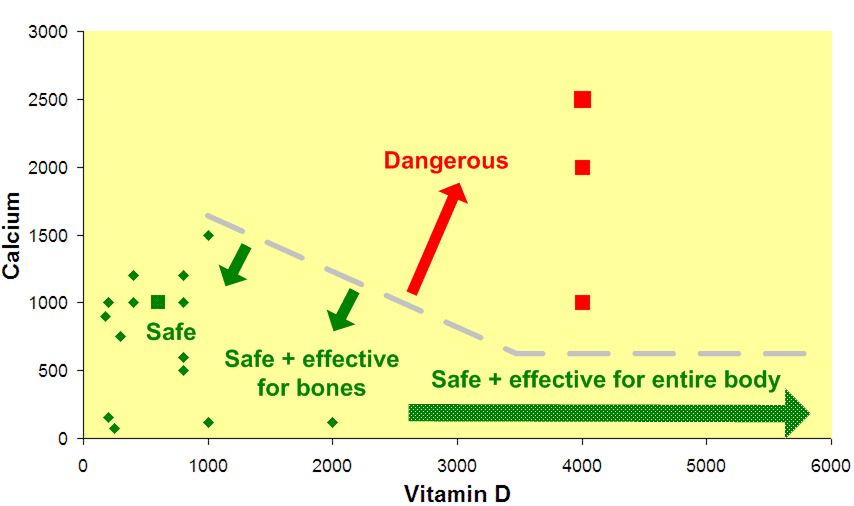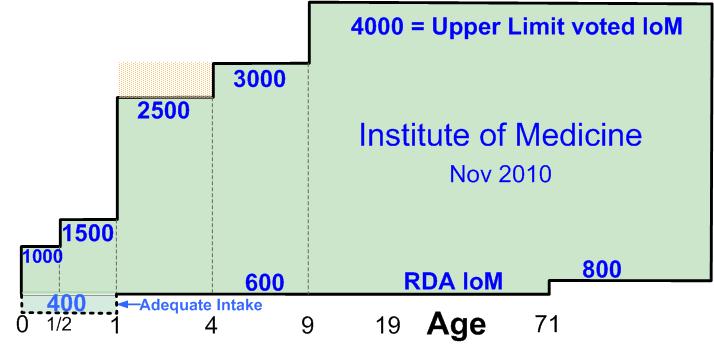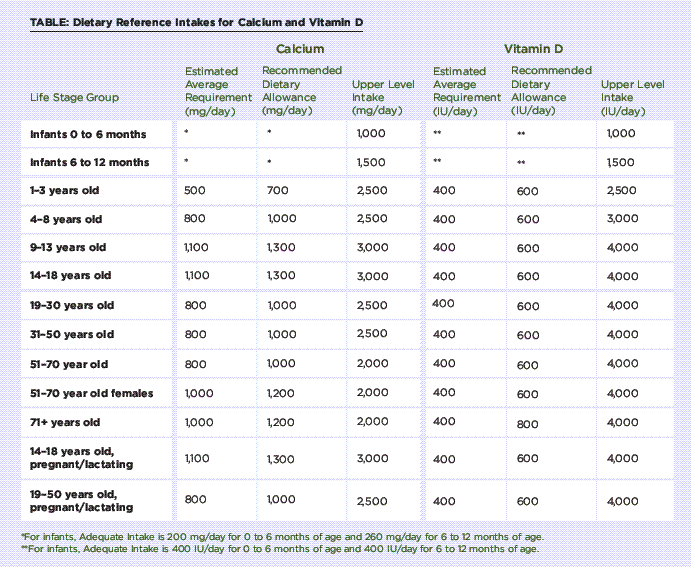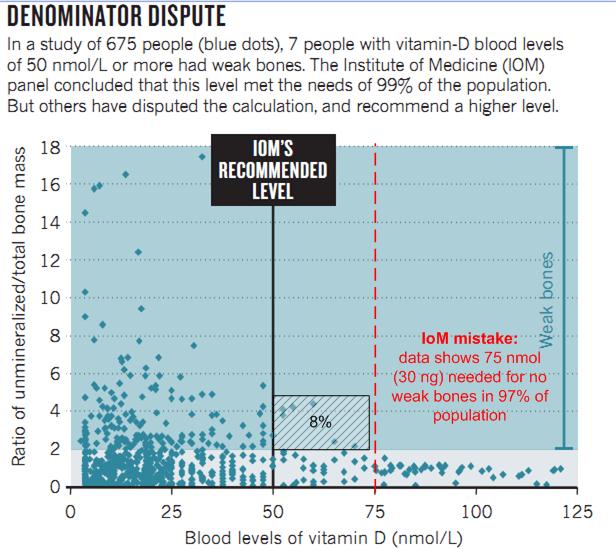IoM again fails to look at interactions
The Institute of Medicine released the latest recommendations for Vitamin D and Calcium Nov 30, 2010
The IoM recommendations often have become the US FDA standards, which then become the world standards

Supplements which combine vitamin D and Calcium (as of Jan-2010) = green diamonds
RDA of Vitamin D and Calcium is safe = green square
The Upper Limit for Vitamin D along with Calcium RDA or Upper Limit are dangerous
The problem: Increasing vitamin D increases the availability of Calcium to the body.
Various studies at the VitaminDWiki show problems with Calcium and Vitamin D above the dashed gray line
Large amount of vitamin D basically may (controversy) multiply the effect of the Calcium in the body by about 4X.
That is, the effect of 2,500 mg of Calcium with 4,000 IU of vitamin D is like taking 4X as much Calcium = 10,000 mg.
The Calcium level in the blood is tightly regulated by the body - so it is the last to change - little point in measuring Calcium in the blood
The body apparently will push some excess Calcium to the urine - when it gets too much vitamin D
Additional Calcium may be deposited in artery walls, kidney stones, and other places in the body.
CLICK HERE for the recommendations of the VitaminDWiki
Note: Co-factors include 500 mg of Calcium
Women probably need more than 500 mg of Calcium while pregnant or nursing

All items in category Calcium items
Is excess calcium harmful to health - 2010

Institute of Medicine detailed table follows

- [tiki-download_file.php?fileId=1595]
The MINIMUM recommendation by 25 experts was higher than the Institute of Medicine 20ng/ml
And the MAXIMUM recommendation was usually 5X higher, 100 ng

CLICK HERE for details
CLICK HERE to get much more information about vitamin D, Calcium, Magnesium, vitamin K2. . .
See also: Wonder about conflict of interest of IoM panel members
2010 Recommendations for Vitamin D are Deficient by two of the 1997 panelists]
An official reviewer of the IOM vitamin D report makes his opinion known – Jan 2011
8% had bone loss when vitamin D higher than 20 ng which has the following graphic

IoM error appears to be due to two reasons
not understanding of statistic
not seeing the data graphically
Comment by WB Grant on NY Times
(also, see his Scientific paper at the bottom of this web page)
The Dietary Reference Intakes for Calcium and Vitamin D committee was constrained in the studies they could use in their evaluation.
They could not use case-control studies in which serum vitamin D was measured at time of diagnosis and they could not consider ecological studies that used solar ultraviolet-B doses as the index of vitamin D production.
Many randomized controlled trials used too little vitamin D (400 IU/day) to find an effect.
The health benefits of vitamin D extend to at least 100 types of disease, with the strongest evidence for many types of cancer (breast, colon, ovarian, pancreatic, prostate, and rectal), cardiovascular disease, diabetes types 1 and 2, respiratory infections such as type A influenza and pneumonia, other infections such as sepsis, autoimmune diseases such as multiple sclerosis.
The level of 25-hydroxyvitamin D (25(OH)D) in the blood, which is measured in vitamin D tests, should be around 40 ng/ml for optimal health.
White Americans on average have 26 ng/ml, while African-Americans have 16 ng/ml due to their darker skin that reduces production of vitamin D from solar UVB.
Raising serum vitamin 25(OH)D levels to 40 ng/ml could reduce mortality rates by 15% in the United States, corresponding to a 2-year increase in life expectancy.
It is amazing that with all the studies in the past decade reporting beneficial effects of vitamin D for a variety of diseases and conditions, a government-sponsored panel could not bring itself to recommend the 1000 to 2000 IU/day required by most people to raise serum 25(OH)D levels to near the optimal value while the FDA will approve a pharmaceutical drug on the basis of one good randomized controlled trial without understanding the adverse effects as in the case of Vioxx.
Those interested in vitamin D can search the web for more information on the health benefits of vitamin D.
Response again by Grant
telling how very constrained the data was that was considered
Is the Institute of Medicine Report on Calcium and Vitamin D Good Science - Jan 2011 Dr. Grant detailed response in Medical journal
Comment by Vitamin D Council - starting with the theme "One Size Fits All"
Today, the FNB has failed millions... 3:00 PM PST November 30, 2010
After 13 year of silence, the quasi governmental agency, the Institute of Medicine's (IOM) Food and Nutrition Board (FNB), today recommended that a three-pound premature infant take virtually the same amount of vitamin D as a 300 pound pregnant woman . While that 400 IU/day dose is close to adequate for infants, 600 IU/day in pregnant women will do nothing to help the three childhood epidemics most closely associated with gestational and early childhood vitamin D deficiencies: asthma, auto-immune disorders, and, as recently reported in the largest pediatric journal in the world, autism. Professor Bruce Hollis of the Medical University of South Carolina has shown pregnant and lactating women need at least 5,000 IU/day, not 600.
The FNB also reported that vitamin D toxicity might occur at an intake of 10,000 IU/day (250 micrograms/day), although they could produce no reproducible evidence that 10,000 IU/day has ever caused toxicity in humans and only one poorly conducted study indicating 20,000 IU/day may cause mild elevations in serum calcium, but not clinical toxicity.
Viewed with different measure, this FNB report recommends that an infant should take 10 micrograms/day (400 IU) and a pregnant woman 15 micrograms/day (600 IU). As a single, 30 minute dose of summer sunshine gives adults more than 10,000 IU (250 micrograms) , the FNB is apparently also warning that natural vitamin D input - as occurred from the sun before the widespread use of sunscreen - is dangerous. That is, the FNB is implying that God does not know what she is doing.
Disturbingly, this FNB committee focused on bone health , just like they did 14 years ago. They ignored the thousands of studies from the last ten years that showed higher doses of vitamin D helps: heart health, brain health, breast health, prostate health, pancreatic health, muscle health, nerve health, eye health, immune health, colon health, liver health, mood health, skin health, and especially fetal health. Tens of millions of pregnant women and their breast-feeding infants are severely vitamin D deficient, resulting in a great increase in the medieval disease, rickets. The FNB report seems to reason that if so many pregnant women have low vitamin D blood levels then it must be OK because such low levels are so common. However, such circular logic simply represents the cave man existence (never exposed to the light of the sun) of most modern-day pregnant women.
Hence, if you want to optimize your vitamin D levels - not just optimize the bone effect - supplementing is crucial. But it is almost impossible to significantly raise your vitamin D levels when supplementing at only 600 IU/day (15 micrograms). Pregnant women taking 400 IU/day have the same blood levels as pregnant women not taking vitamin D; that is, 400 IU is a meaninglessly small dose for pregnant women . Even taking 2,000 IU/day of vitamin D will only increase the vitamin D levels of most pregnant women by about 10 points, depending mainly on their weight. Professor Bruce Hollis has shown that 2,000 IU/day does not raise vitamin D to healthy or natural levels in either pregnant or lactating women. Therefore supplementing with higher amounts - like 5000 IU/day - is crucial for those women who want their fetus to enjoy optimal vitamin D levels, and the future health benefits that go along with it.
For example, taking only two of the hundreds of recently published studies: Professor Urashima and colleagues in Japan, gave 1,200 IU/day of vitamin D3 for six months to Japanese 10-year-olds in a randomized controlled trial. They found vitamin D dramatically r educed the incidence of influenza A as well as the episodes of asthma attacks in the treated kids while the placebo group was not so fortunate. If Dr. Urashima had followed the newest FNB recommendations, it is unlikely that 400 IU/day treatment arm would have done much of anything and some of the treated young teenagers may have come to serious harm without the vitamin D. Likewise, a randomized controlled prevention trial of adults by Professor Joan Lappe and colleagues at Creighton University, which showed dramatic improvements in the health of internal organs, used more than twice the FNB's new adult recommendations.
Finally, the FNB committee consulted with 14 vitamin D experts and – after reading these 14 different reports – the FNB decided to suppress their reports . Many of these 14 consultants are either famous vitamin D researchers, like Professor Robert Heaney at Creighton or, as in the case of Professor Walter Willett at Harvard, the single best-known nutritionist in the world. So, the FNB will not tell us what Professors Heaney and Willett thought of their new report? Why not?
Today, the Vitamin D Council directed our attorney to file a federal Freedom of Information (FOI) request to the IOM's FNB for the release of these 14 reports.
Most of my friends, hundreds of patients, and thousands of readers of the Vitamin D Council newsletter (not to mention myself), have been taking 5,000 IU/day for up to eight years. Not only have they reported no significant side-effects, indeed, they have reported greatly improved health in multiple organ systems. My advice, especially for pregnant women: continue taking 5,000 IU/day until your 25(OH)D is between 50-80 ng/mL (the vitamin D blood levels obtained by humans who live and work in the sun and the mid-point of the current reference ranges at all American laboratories). Gestational vitamin D deficiency is not only associated with rickets, but a significantly increased risk of neonatal pneumonia, a doubled risk for preeclampsia, a tripled risk for gestational diabetes, and a quadrupled risk for primary cesarean section.
Today, the FNB has failed millions of pregnant women whose as yet unborn babies will pay the price. Let us hope the FNB will comply with the spirit of "transparency" by quickly responding to our Freedom of Information requests.
John Cannell, MD, The Vitamin D Council, 1241 Johnson Avenue, #134
Excellent interview of Dr. Cannell by Dr. Mercola Dec 1 2010
Covers a lot of interesting vitamin D topics - not just the Institue of Medicine
Some of our comments to this report on the web
Enough for the bones, not for the body
The focus of the report was for BONE health, not BODY health.
Most Americans are getting enough to prevent rickets.
Also, they again failed to notice interactions - this time between Calcium and vitamin D
- see https://www.VitaminDWiki.com/tiki-index.php?page_id=1193
The report is for BONE health, not BODY health.
Yes, only need 800 IU to prevent rickets, but need a lot more vitamin D to prevent many diseases,
See https://www.VitaminDWiki.com
Old information
The reports for rickets has not changed much in the past 2 years, so the report, which they clearly say is for BONE health, not BODY health is correct.
Yes, only need 800 IU to prevent rickets.
But random controlled trials of the past 2 years have found that we need a lot more to vitamin D prevent many diseases,
See https://www.VitaminDWiki.com
TOTALLY WRONG SUMMARY:
The report clearly says that 600 IU in the minimum vitamin D for bone health = prevent rickets.
It is not only safe to take more vitamin D, but far more is needed to prevent a wide variety of diseases.
see https://www.VitaminDWiki.com/tiki-index.php?page_id=1193
Two committee?
There is a LOT of evidence, even in the IoM 2009 briefing papers, of problems with too much Calcium when you have the 'vitamin D catalyst'
It almost seems that the IoM had two committees:
Calcium committee
Vitamin D committee
and the committees did not talk to each other
See also at VitaminDWiki
Use Google customer search to find "vitamin D Council" 870 hits as of Dec 11, 2010
- Vitamin D Recommendations mainly since 2009 in both IU and ng
Yet more reaction to the pronouncement
HealthScan Blog "What the IoM should have said"
Responses by vitamin D researchers including Heaney, Camargo, Giovannucci, Grant, Whiting, White, Garland,
Good links to many other comments on the IoM pronouncement
Dr. Mark Hyman reviewed the IoM report
One of his comments - since the IoM lowered the vitamin D level so as to be compatable with the norm of the US vitamin D,
the government should raise the level obesity level so so as to be compatible with the norm of the US weight.
Dr. Hyman byline: I practice the medicine of why instead of the medicine of what , asking ' Why are you sick', and not ' What disease do you have?'
About.com section on Colon Cancer reaction to the pronouncement
Dr Fuhrman at Huffington Post Dec 25
Many experts are weighing in on -- and disagreeing with -- the IOM's report, and there is general agreement among the experts on these points:
The increase of the tolerable upper limit to 4,000 IU is a positive change.
The IOM's definition of 20 ng/ml as a sufficient 25(OH)D is potentially low, and this could be dangerous for some people
The lack of randomized controlled trials does not mean that we should ignore the epidemiological evidence showing vitamin D's importance for preventing non-skeletal diseases.
Guidelines for safe and effective supplementation with vitamin D:
Find out your 25(OH)D level
Adjust supplementation accordingly to remain in the range of 35-55 ng/ml
If you do not yet know your 25(OH)D levels, approximately 2000 IU is a reasonable dose of vitamin D to take until you can get your levels tested.
Mercola March 2011
Long article on importance of Vitamin K2 and Vitamin D and problems with excess CALCIUM
Problems of excess Calcium

Must balance co-factors when increasing vitamin D
short url = http://is.gd/CaVitD
